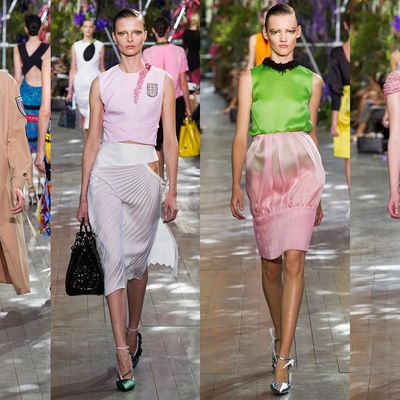
The fact that so many customers and admirers attend a Christian Dior fashion show – in addition to the usual editors and retailers – is highly instructive in how a collection will ultimately work outside the fashion bubble.
The invited guests tend to arrive dressed in the latest Dior kit and they did not disappoint Friday afternoon. The women favored side-swept skirts with generous tucks and folds cascading down one hip. They also had an affinity for the more formal skirts that were thigh-length in front while dropping to the ankle in the back. No matter that the sun was still shining brightly on an unseasonably warm September day – if it was woolen cocktail attire that they had from the current season, well then, what the heck? That is what they wore.
Attractiveness is a subjective thing and diplomacy is preferable to unkind bluntness. Oftentimes, the clothes did not do justice to the wearer’s inherent beauty. This is not because they were ill-fitting or oddly colored but because they were simply difficult to wear. They were clothes that required a specific body type — long and lean. And they demanded a certain carriage: The theatrical nonchalance of an experienced model. They also needed the right setting, which sounds like an especially odd thing to say since what could be a more perfect moment to wear a Dior princess skirt than to a Dior fashion show?
But in the middle of a Dior universe, constructed in the courtyard of the Rodin Museum from scaffolding and more flowers than in the Hanging Gardens of Babylon, the clothes looked self-conscious and fussy. They looked like costumes.
Their true home was the fantasy world of the runway. And their ideal customer was a model.
This was worth remembering as designer Raf Simons unveiled his spring 2014 collection. On the runway, with thousands of flowers hanging from the ceiling, the clothes were fanciful and feminine and steeped in the traditions of the house. Short pleated skirts flounced beneath tailored jackets that curved over the hips. Cropped “Bar” jackets were adorned with sparkling patches that called to mind old-fashioned passport stamps and travel stickers. Shirtdresses twisted around the body and the functional front placket, with its discreet buttons, became decorative as it curved around the waist and along the hip. Boxy double-breasted jackets shined in metallic pastels. A delicate bubble skirt in pale pink was paired with a grass-green satin shell.
Simons noted that the collection was divided into three categories: “Traveller, Transformer and Transporter,” although, aside from the travel patches, it was difficult determining where the other pieces fit. Some of the most beautiful looks from the collection were in the finale, where Simons reprised some of his own aesthetic strokes from his debut collection. Silver brocade ball dresses were cropped and worn over skinny black trousers; others were left full length to billow out extravagantly. Tuxedo jackets became minidresses, or were elongated and paired with trousers for a sexy example of fine tailoring.
The oddest silhouettes on the runway were the pleated skirts merged with shorts. While this splicing of fashion DNA might have been an intoxicating experiment in the Dior atelier, the result left the impression that the models had simply yanked on a pair of shorts over their skirts and left bits of them hanging out. Risk-taking is admirable, but this just looked like tomfoolery.
Which brings us back to the ladies of Dior – the customers, the admirers, the supplicants. It was hard to imagine much of what was on the runway doing them a service. And God help them if they tried to wiggle into that diaper-short-skirt contraption.
The models could only just barely make an argument that the vast majority of these clothes had a place on a city street or even at some rarified party. It was fairly unconvincing. One pale pleated skirt had a circular cutout over the hipbone. How many hipbones should ever be revealed any place other than a beach? Exactly, one. And we’ve already seen it. In 1996, at Gucci, when Tom Ford’s iconic white jersey gown revealed the left hipbone of Carolyn Murphy and it was magnificent.
Simons put a host of interesting ideas on the runway. But most felt like proposals and possibilities. They were not offered in a high-minded or pretentious manner. He was not trying to appeal to the intellect so that a woman might enjoy the premise of a dress without ever considering it as clothing.
Instead, they read like the experiments of a vastly talented designer enjoying the resources at his disposal but forgetting that the limits of his customers are very real.




